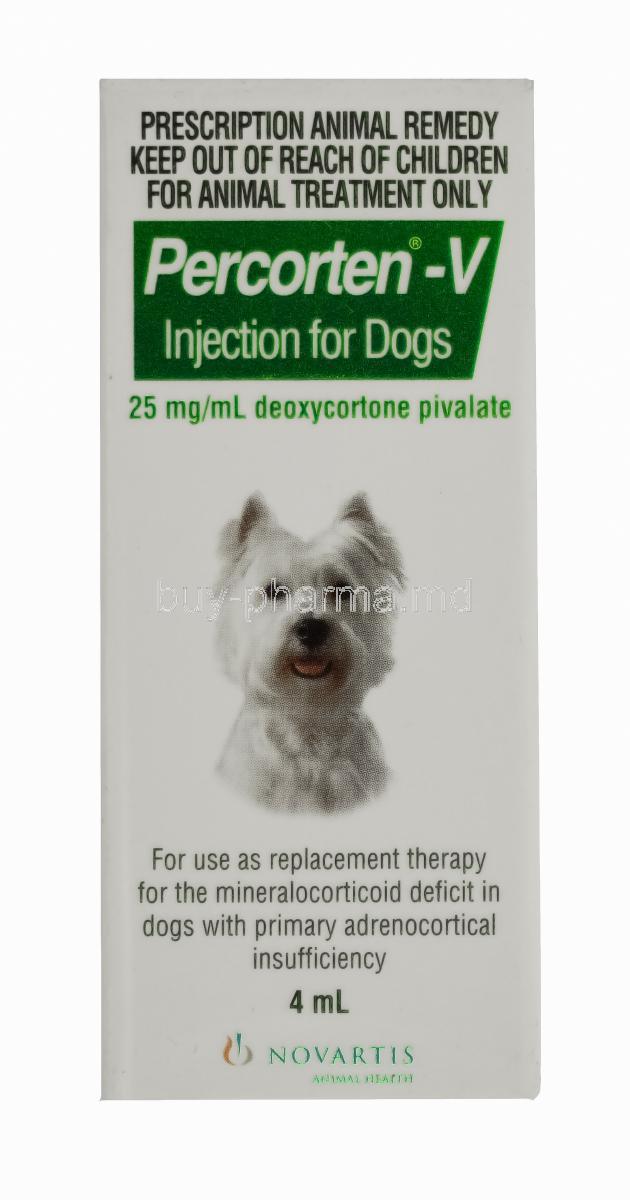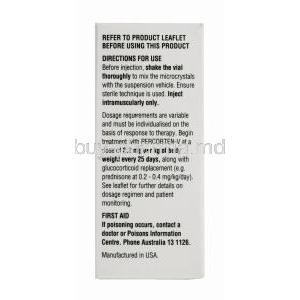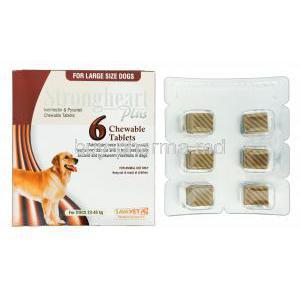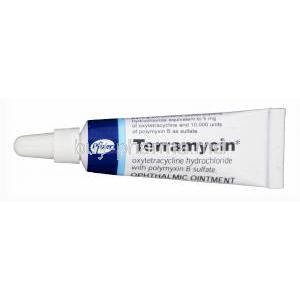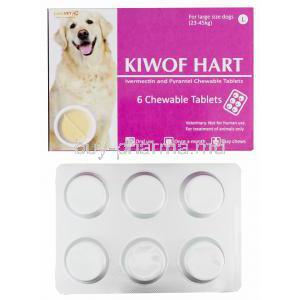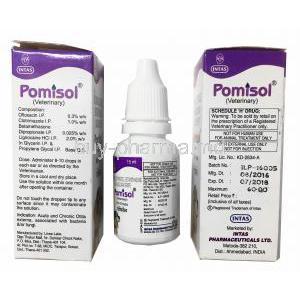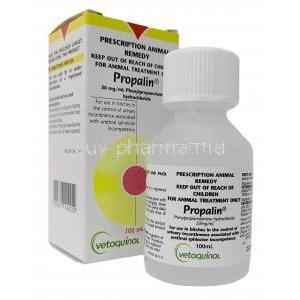Introduction to Percorten-V Injection for Dogs
Overview of Percorten-V and its Veterinary Classification
Percorten-V is a long-acting injectable suspension containing desoxycorticosterone pivalate (DOCP), classified as a mineralocorticoid hormone replacement therapy. It is a critical pharmaceutical agent in veterinary endocrinology, formulated specifically for canine use.
Importance in Canine Endocrine Therapy
This medication plays a pivotal role in managing adrenal gland disorders, particularly when the body fails to produce adequate amounts of aldosterone. Its use ensures proper electrolyte balance and systemic homeostasis, preventing life-threatening complications in dogs with endocrine dysfunctions.
FDA Approval and Veterinary Prescription Status
Percorten-V is FDA-approved for veterinary use and is available by prescription only. Its safety and efficacy have been well-established for dogs with primary adrenal insufficiency, making it the treatment of choice in these cases.
Targeted Conditions and Species Specificity
Specifically designed for canine patients, Percorten-V is not approved for use in other species. It is targeted for treating Addison’s disease (hypoadrenocorticism) and related adrenal disorders in dogs.
Veterinary Uses of Percorten-V Injection
2.1 Approved Use: Primary Adrenal Insufficiency (Addison’s Disease)
Explanation of Addison’s Disease in Dogs
Addison’s disease, or primary hypoadrenocorticism, is a chronic condition characterized by insufficient production of adrenal hormones, particularly aldosterone. This leads to imbalances in sodium, potassium, and water levels, causing lethargy, vomiting, and potentially fatal collapse.
Role of Percorten-V in Hormone Replacement Therapy
Percorten-V substitutes the mineralocorticoid hormone aldosterone, effectively stabilizing sodium and potassium levels. It restores the body’s electrolyte equilibrium, which is essential for nerve function, hydration, and cardiovascular stability.
Clinical Benefits and Symptom Control
Dogs treated with Percorten-V often experience dramatic improvement:
- Resolution of lethargy and weakness
- Improved appetite and hydration status
- Normalized electrolyte panels
Consistent administration can lead to long-term disease control and improved quality of life.
2.2 Off-Label Uses of Percorten-V in Veterinary Medicine
Use in Atypical Addison’s Disease
Although atypical Addison’s disease primarily lacks mineralocorticoid deficiency, some veterinarians may introduce Percorten-V in advanced or evolving cases where electrolyte imbalance emerges.
Use in Managing Secondary Adrenal Insufficiency
In rare cases of secondary adrenal failure, where pituitary dysfunction affects adrenal hormone output, Percorten-V may be used in combination with glucocorticoids to address overlapping deficiencies.
Potential Use in Stress-Induced Adrenal Crisis Prevention
Some clinicians employ Percorten-V prophylactically in high-risk dogs undergoing surgery or severe stress to prevent adrenal crisis in undiagnosed or borderline cases.
How Percorten-V Works in Dogs
Mechanism of Action of Desoxycorticosterone Pivalate (DOCP)
DOCP mimics the action of natural aldosterone, binding to mineralocorticoid receptors in the kidneys to promote sodium reabsorption and potassium excretion. This hormonal activity regulates fluid balance and blood pressure.
Role in Regulating Electrolyte Balance
Percorten-V’s primary therapeutic benefit lies in its ability to:
- Retain sodium and water in the bloodstream
- Eliminate excess potassium via the urine
- Maintain normal blood volume and pressure
Support of Renal and Cardiovascular Function
By stabilizing electrolyte and fluid levels, Percorten-V helps preserve kidney function and cardiac output, reducing the risk of shock, arrhythmias, and organ damage associated with adrenal insufficiency.
Dosage and Administration Guidelines
4.1 Standard Dosage Protocol
Initial Dose Recommendations
The initial dosage typically starts at 2.2 mg/kg body weight, administered as a subcutaneous or intramuscular injection.
Frequency of Administration
Injections are repeated every 25 to 30 days. Over time, the dosing interval may be tailored based on the patient’s response.
Injection Techniques
Both subcutaneous and intramuscular routes are acceptable, with the subcutaneous method being preferred for ease of administration and lower risk of injection site complications.
4.2 Individualized Dosing and Monitoring
Adjustments Based on Clinical Response
Ongoing monitoring of clinical signs and serum electrolytes guides dosing adjustments. Signs of over- or under-supplementation prompt reevaluation.
Role of ACTH Stimulation Testing
Although not always required for maintenance, ACTH stimulation testing may be used to confirm diagnosis and assess adrenal reserve before initiating therapy.
Veterinary Monitoring Schedule
Routine monitoring includes:
- Sodium and potassium levels every 2–3 months
- Blood pressure evaluations
- Weight and hydration status assessments
Composition and Pharmaceutical Formulation
Active Ingredient: Desoxycorticosterone Pivalate Concentration
Each milliliter of Percorten-V contains 25 mg of desoxycorticosterone pivalate.
Inactive Components and Preservatives
Formulated with aqueous vehicle and preservatives such as benzyl alcohol to ensure sterility and stability.
Injectable Suspension Form and Packaging Options
Percorten-V is available as a sterile aqueous suspension in multi-dose vials, typically in 4 mL or 10 mL sizes, suitable for long-term use.
Storage Instructions for Percorten-V
Recommended Temperature Range for Storage
Store between 15°C and 30°C (59°F–86°F). Do not freeze.
Light and Moisture Protection
Keep vials tightly sealed and protected from direct sunlight and humidity to preserve potency.
Shelf Life and Stability After Opening
Once punctured, the vial should be used within 60 days. Inspect for particulate matter or discoloration before each use.
Potential Drug Interactions
Interaction with Glucocorticoids (e.g., Prednisone)
Percorten-V is typically administered alongside glucocorticoids to provide full adrenal replacement. Monitor for signs of steroid excess or deficiency.
Diuretic Use and Electrolyte Disturbances
Concurrent use with diuretics (e.g., furosemide) may potentiate potassium loss. Monitor electrolytes closely and adjust dosages accordingly.
Possible Interactions with Antihypertensives
Since Percorten-V may increase blood pressure through sodium retention, it can antagonize antihypertensive drugs, necessitating blood pressure monitoring.
Monitoring with Insulin in Diabetic Dogs
In diabetic patients, hormonal changes may affect glucose metabolism. Coordination with insulin therapy and blood sugar tracking is critical.
Warnings and Veterinary Precautions
Risk of Electrolyte Imbalance and Hypertension
Excessive dosing can lead to hypernatremia and hypokalemia, increasing the risk of hypertension and cardiac arrhythmias.
Need for Regular Veterinary Assessment
Regular checkups, blood tests, and physical exams are essential to maintain electrolyte equilibrium and adjust therapy as needed.
Warning Signs Indicating Dose Adjustments or Discontinuation
Signs such as excessive thirst, bloating, muscle weakness, or weight gain may indicate improper dosing and warrant immediate veterinary attention.
Monitoring Renal Function and Cardiovascular Status
Long-term use necessitates renal panel assessments and blood pressure evaluations, particularly in geriatric or comorbid patients.
Contraindications for Use of Percorten-V
Known Hypersensitivity to DOCP or Any Component
Percorten-V should not be administered to dogs with known allergies to desoxycorticosterone pivalate (DOCP) or any of the excipients present in the formulation. Hypersensitivity reactions, though rare, may include anaphylaxis, dermatologic eruptions, or angioedema.
Presence of Congestive Heart Failure
Due to its potent sodium-retaining properties, Percorten-V may exacerbate fluid overload in dogs with congestive heart failure. The increase in intravascular volume can place undue stress on the myocardium, risking decompensation.
Severe Renal Disease Without Concurrent Corticosteroid Support
In dogs with advanced renal insufficiency, the mineralocorticoid effects of DOCP may worsen electrolyte imbalances and fluid retention. Without the concurrent administration of glucocorticoids, the therapeutic balance may be insufficient to maintain homeostasis, posing clinical risks.
Careful Administration and Monitoring Considerations
10.1 Dogs with Cardiac Conditions
Sodium Retention and Its Cardiovascular Implications
DOCP increases sodium retention, which expands extracellular fluid volume. In dogs with pre-existing heart disease, this may lead to exacerbated preload and reduced cardiac output.
Requirement for Low-Dose Initiation and Close Monitoring
Starting treatment with a reduced dose and titrating slowly under veterinary supervision helps minimize cardiovascular strain. Regular blood pressure checks and auscultation for murmurs are recommended.
10.2 Dogs with Renal Impairment
Risk of Fluid Overload and Potassium Depletion
Impaired renal filtration capacity may intensify the risk of fluid overload. Simultaneously, DOCP-induced potassium excretion can precipitate hypokalemia.
Dose Adjustment and Renal Panel Monitoring
Tailoring the dose based on renal function and conducting periodic renal panels (creatinine, BUN, electrolyte levels) ensures safe and effective therapy.
10.3 Concurrent Use with Corticosteroids
Balancing Glucocorticoid and Mineralocorticoid Therapy
Dogs receiving DOCP typically also require glucocorticoid supplementation (e.g., prednisone) to manage cortisol deficiency. The balance between these two hormones is critical for metabolic and stress response regulation.
Monitoring for Signs of Over-Suppression or Deficiency
Over-suppression may present as weight gain, immunosuppression, or panting, whereas under-dosing may lead to fatigue, vomiting, or anorexia. Veterinary evaluation should guide adjustments.
Important Precautions Before and During Treatment
Baseline Electrolyte Testing and Physical Examination
Establishing sodium and potassium levels prior to initiating Percorten-V allows for accurate dosing. A comprehensive physical examination helps identify comorbid conditions that may influence treatment safety.
Avoidance of Sudden Discontinuation
Abrupt cessation of therapy can precipitate adrenal crisis, leading to circulatory collapse. Any changes to the treatment plan must be gradual and supervised.
Client Education on Signs of Overdose or Underdose
Pet owners should be counseled to observe:
- Overdose: lethargy, bloating, tremors
- Underdose: vomiting, dehydration, collapse
Long-Term Management Strategy for Chronic Addison’s Disease
Addison’s disease requires lifelong therapy. Routine follow-ups, electrolyte rechecks, and dose titrations are part of a sustainable care plan.
Common and Serious Side Effects in Dogs
12.1 Common Adverse Effects
Increased Thirst and Urination (PU/PD)
Mild polyuria and polydipsia are frequently observed, especially shortly after administration, and typically resolve as electrolyte balance stabilizes.
Swelling at the Injection Site
Transient local inflammation, warmth, or a palpable lump may occur and generally subsides within a few days.
Mild Gastrointestinal Upset
Some dogs may exhibit nausea, decreased appetite, or soft stools during the initiation phase.
12.2 Serious or Rare Side Effects
Electrolyte Imbalances: Hypernatremia, Hypokalemia
Severe imbalances can result in muscle weakness, tremors, or cardiac arrhythmias. These require prompt correction and possible dose reevaluation.
Hypertension or Fluid Retention Complications
Excessive sodium retention may lead to high blood pressure and edema, particularly in dogs with underlying cardiovascular or renal disorders.
Allergic Reactions: Swelling, Hives, or Anaphylaxis
Although rare, hypersensitivity may present suddenly and requires emergency veterinary care.
Administration to Special Populations
13.1 Use in Geriatric Dogs
Consideration of Comorbidities
Older dogs often suffer from concurrent conditions such as renal insufficiency, cardiac disease, or diabetes, which can complicate treatment.
Lower Initial Dosing and Gradual Titration
A conservative dosing approach with slow titration minimizes adverse effects and allows better physiological adaptation.
13.2 Use in Pregnant and Nursing Dogs
Lack of Adequate Safety Studies
There are no well-controlled studies in pregnant or lactating dogs. Use is typically avoided unless absolutely necessary.
Potential Impact on Fetal and Neonatal Development
Hormonal modulation could affect fetal electrolyte homeostasis or neonatal growth, though data is limited.
Risk-Benefit Evaluation by the Veterinarian
The attending veterinarian must assess the maternal health risks versus the potential fetal or neonatal outcomes before proceeding.
13.3 Use in Puppies and Juvenile Dogs
Safety in Young Animals Not Fully Established
Immature renal and endocrine systems may respond unpredictably to mineralocorticoid therapy.
Growth and Hormonal Development Considerations
Long-term use in juveniles could theoretically interfere with bone growth, metabolic rate, or puberty.
Dosing Frequency Adjustments in Smaller Breeds
Smaller dogs may require more frequent monitoring and customized dose intervals to avoid under- or over-supplementation.
Overdose Management and Toxicity Symptoms
Signs of Overdose: Lethargy, Weakness, Hypertension
Symptoms may include fatigue, panting, fluid retention, or sudden collapse. Prompt recognition is essential to prevent irreversible harm.
Electrolyte Panel Abnormalities
Laboratory findings may reveal:
- Elevated sodium (hypernatremia)
- Suppressed potassium (hypokalemia)
- Increased blood pressure
Emergency Veterinary Interventions
Immediate management includes:
- IV fluid therapy to restore balance
- Reduction or cessation of DOCP
- Supplemental potassium if necessary
Long-Term Monitoring After Overdose Event
Ongoing evaluations are crucial to avoid recurrence. Adjustments to the dosing schedule and interval are typically required.
Safe Handling and Administration Precautions
Proper Storage and Handling of Injectable Suspension
Store in a cool, dry place away from sunlight. Shake well before each use to maintain uniform suspension.
Needle Disposal and Veterinary Technician Safety
Used needles and syringes should be discarded in puncture-proof sharps containers. Personnel should wear gloves and follow aseptic technique.
Avoiding Contamination During Dose Preparation
Use sterile equipment and avoid multiple punctures of the vial. Ensure the rubber stopper is disinfected before each withdrawal.
Guidelines for Pet Owners Administering at Home
If home administration is prescribed:
- Owners should be trained in proper injection technique
- Instructions on storage and handling must be clear
- Owners must monitor their pet for adverse reactions and report abnormalities promptly
Percorten-V Injection For Dogs FAQ
- What is Percorten-V used for?
- How often should I give percorten to dogs?
- How to give percorten injection for dogs?
- What is the route of administration for percorten?
- What is the alternative to percorten?
- What happens if I give my dog too much percorten?
- What are the long-term side effects of percorten in dogs?
- How to store percorten for dogs?
- What class of drug is Percorten-V?
- What is a vial of Percorten-V for dogs 25 mg ml?
- What is the other name for percorten?
- Who makes percorten?
- What is Percorten-V used for?
- How often should I give percorten to dogs?
- How to give percorten injection for dogs?
- What is the alternative to percorten?
- What are the long-term side effects of percorten in dogs?
- How to store percorten for dogs?
- Who makes percorten?
What is Percorten-V used for?
Percortan V is a type of corticosteroid that is employed to address situations where the body fails to produce enough steroids.
How often should I give percorten to dogs?
Every 25 days
How to give percorten injection for dogs?
Patients typically receive Percortren V subcutaneously or intramuscularly every 20 to 30 days for effectiveness.
What is the route of administration for percorten?
Injected intramuscularly
What is the alternative to percorten?
Zycortal Suspension
What happens if I give my dog too much percorten?
Depression/lethargy, vomiting, anorexia, polydipsia, and polyuria
What are the long-term side effects of percorten in dogs?
It could lead to urination and thirst, as well as swelling due to increased blood volume and heart enlargement. It may also suggest retaining fluids caused by holding onto sodium if there is a significant increase in weight.
How to store percorten for dogs?
Store Percortn V, in a place, at room temperature avoiding exposure to moisture and heat.
What class of drug is Percorten-V?
Corticosteroid; Mineralocorticoid
What is a vial of Percorten-V for dogs 25 mg ml?
Veterinarians often prescribe Percortin V for treating Addison's disease in dogs.
What is the other name for percorten?
Desoxycorticosterone pivalate
Who makes percorten?
Elanco
What is Percorten-V used for?
Percortan V is a type of corticosteroid that is utilized to address situations where the body lacks in generating its own steroids.
How often should I give percorten to dogs?
Every 25 days
How to give percorten injection for dogs?
Patients typically receive Percortin V through intramuscular injections every 20 to 30 days.
What is the alternative to percorten?
Zycortal Suspension
What are the long-term side effects of percorten in dogs?
It could lead to urination (polyuria), excessive thirst (polydipsia), higher blood volume levels, causing swelling (edema), and enlargement of the heart muscle ( enlargement). If there is an increase, in weight observed it might suggest that the body is holding onto fluids due, to retaining sodium.
How to store percorten for dogs?
Store Percortin V should be kept at room temperature, away from moisture and heat.
Who makes percorten?
Elanco

